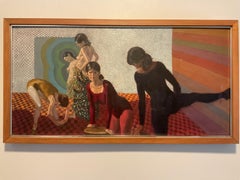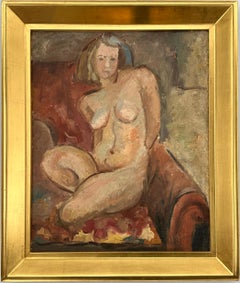Lisa Matrundola Paintings
to
2
Overall Width
to
Overall Height
to
2
2
2
2
2
2
1
1
1
1
2
2
2
781
715
711
692
2
Artist: Lisa Matrundola
Butterfly 1, 2018
By Lisa Matrundola
Located in Atlanta, GA
Lisa Matrundola was born the youngest of five children in Montreal, Quebec. Her parents immigrated to Canada from Italy and England in the mid 1950’s. Self-sufficiency, hard work and...
Category
21st Century and Contemporary Modern Lisa Matrundola Paintings
Materials
Oil
Butterfly 2, 2018
By Lisa Matrundola
Located in Atlanta, GA
Lisa Matrundola was born the youngest of five children in Montreal, Quebec. Her parents immigrated to Canada from Italy and England in the mid 1950’s. Self-sufficiency, hard work and...
Category
21st Century and Contemporary Modern Lisa Matrundola Paintings
Materials
Oil
Related Items
Mid Century Modern Dancers Oil Painting; Listed Artist Albert Michini, ca 1970’s
Located in Baltimore, MD
If you have an association with dance, yoga or working out, this unusual modernist painting might be an interesting addition to your space. Artist Albert Michini used several models ...
Category
1970s American Modern Lisa Matrundola Paintings
Materials
Oil
The Artist's Wife oil painting by Hans Burkhardt
By Hans Burkhardt
Located in Hudson, NY
Hans Burkhardt
The Artist's Wife (1930)
Oil on canvas, 20" x 16"
24" x 20 ½" x 1 ½" framed
Dated 1930 lower right recto. Annotated "To Elsa HB Louise Burkhardt 1930. HB" verso.
...
Category
1930s American Modern Lisa Matrundola Paintings
Materials
Canvas, Oil
Seated Figure
Located in Rockland, ME
Sally Michel Biography
American, 1902-2003
Sally Michel Avery was an American painter known for her lyrical depictions of everyday life. Though she used techniques and stylized form...
Category
1980s American Modern Lisa Matrundola Paintings
Materials
Oil
Fish Story oil painting by Williams Charles Palmer
Located in Hudson, NY
This painting is illustrated in the Catalogue of the 1945 Encyclopedia Britannica Collection of Contemporary American Painting, p.84. Written and edited by Grace Pagano.
"Painting ...
Category
Mid-20th Century American Modern Lisa Matrundola Paintings
Materials
Canvas, Oil
$7,500
H 30 in W 36 in
Lords of the Sky oil painting by Julio De Diego
By Julio de Diego
Located in Hudson, NY
Lords of the Sky (c.1950)
Oil on canvas, 30" x 24"
40" x 34" x 2" framed
Provenance: The Artist, his daughter
About this artist: Julio De Diego crafted a formidable persona within ...
Category
Mid-20th Century Modern Lisa Matrundola Paintings
Materials
Canvas, Oil
Floral painting, abstract floral large scale oil painting
Located in Basalt, CO
This 60" x 48" original floral oil painting called "Charmed" is one of the first in Tania's body of large format flower-inspired oil paintings. On a sprawling 60" canvas, hues of gr...
Category
2010s Modern Lisa Matrundola Paintings
Materials
Oil
$22,500
H 60 in W 48 in D 1.5 in
Homage to the Spanish Republic 1938 oil painting by Julio De Diego
By Julio de Diego
Located in Hudson, NY
An early work by Julio De Diego embodies the deep love he had for his homeland of Spain, combined with his strong emotions against war. The peacefulness of the couple holding hands l...
Category
1930s Modern Lisa Matrundola Paintings
Materials
Masonite, Oil
$26,500
H 36 in W 30 in
The Junkman's Serenade oil painting by Gregorio Prestopino
By Gregorio Prestopino
Located in Hudson, NY
This work epitomizes Prestopino's interest in social realism which captures a quiet interlude in the everyday life of an "everyman." It also provides a contrast for our expectations as we view a tough, blue collar worker, with no one watching, as he sings a melody to the birds.
In an original frame measuring 49" x 39" x 3.25"
Provenance: Edith Halpert's Downtown Gallery (label verso from 13 w. 113th street, where the gallery was located from 1926 until 1939)
Private collection, NYC, c. 1935
By descent
About this artist: Born in Little Italy in 1907, Gregorio Prestopino first set out to become a sign painter as the son of New York City immigrants. Instead, his talent provided a life-changing scholarship to the National Academy of Design, and for five years he studied drawing under C. W. Hawthorne. He spent the summer of 1934 at the MacDowell Colony in Peterborough, New Hampshire. His deep involvement with the colony led him to later serve as its director in 1954.
Much of Prestopino’s work was in the vein of social realism. During the 1940s and 1950s he became deeply invested in portraying everyday Manhattan and Harlem scenes. He first became interested in the Ashcan school at the National Academy of Design, and remained committed to an interest in working with urban scenes. His lively treatment of people and events revealed his affinity for sixteenth-century artist Pieter Breughel...
Category
Early 20th Century Modern Lisa Matrundola Paintings
Materials
Canvas, Oil
A Day at the Beach
Located in New Orleans, LA
A Day at the Beach by unkown American School painter, circa 1940-1950, oil on canvas.
Framed: 31 x 29 inches
Category
Mid-20th Century Modern Lisa Matrundola Paintings
Materials
Canvas, Oil
Untitled oil painting of children playing by Eugenie Schein
Located in Hudson, NY
Eugenie Schein was both a dancer and an artist. Her artwork subjects revolved primarily around dancers and dancing, though she also captured everyday scenes in New York.
Both Midto...
Category
1940s Modern Lisa Matrundola Paintings
Materials
Canvas, Oil
$2,000
H 10 in W 12 in
On the Beach modernist oil painting by Byron Browne
By Byron Browne
Located in Hudson, NY
Byron Browne
On the Beach (1959)
Oil on canvas, 20" x 26"
26" x 32" x 1" frame size - likely original
Inscribed verso "On the Beach / 1959 / Byron Browne"
Provenance: Private collection, Berkley, California
About this artist: Through an oeuvre displaying the re-envisioning of figural subjects and the formation of an abstract expressionist style, Byron Browne stands out among the American abstractionists of his generation. Born in Yonkers, New York, in 1907, the artist was a bright talent at the National Academy of Design in his teens. From 1924 to 1928 Browne studied at the Academy under notable artists Robert Aitkin, Charles Courtney Curran, Charles Hawthorne, Alice Murphy...
Category
Mid-20th Century Modern Lisa Matrundola Paintings
Materials
Canvas, Oil
Folk Singer oil painting by Byron Browne
By Byron Browne
Located in Hudson, NY
Lovely oil painting by Byron Browne. Measures 18" x 14" and framed 24" x 20" x 1 3/4".
Signed "Byron Browne" lower left.
Inscribed on canvas verso: Byron Browne / 1958 / – Folk Singer– / 18 x 14 / N.Y.C.
About this artists: Through an oeuvre displaying the re-envisioning of figural subjects and the formation of an abstract expressionist style, Byron Browne stands out among the American abstractionists of his generation. Born in Yonkers, New York, in 1907, the artist was a bright talent at the National Academy of Design in his teens. From 1924 to 1928 Browne studied at the Academy under notable artists Robert Aitkin, Charles Courtney Curran, Charles Hawthorne, Alice Murphy...
Category
1950s Modern Lisa Matrundola Paintings
Materials
Canvas, Oil
Lisa Matrundola paintings for sale on 1stDibs.
Find a wide variety of authentic Lisa Matrundola paintings available for sale on 1stDibs. You can also browse by medium to find art by Lisa Matrundola in oil paint, paint and more. Much of the original work by this artist or collective was created during the 21st century and contemporary and is mostly associated with the modern style. Not every interior allows for large Lisa Matrundola paintings, so small editions measuring 18 inches across are available. Lisa Matrundola paintings prices can differ depending upon medium, time period and other attributes. On 1stDibs, the price for these items starts at $3,900 and tops out at $3,900, while the average work can sell for $3,900.



